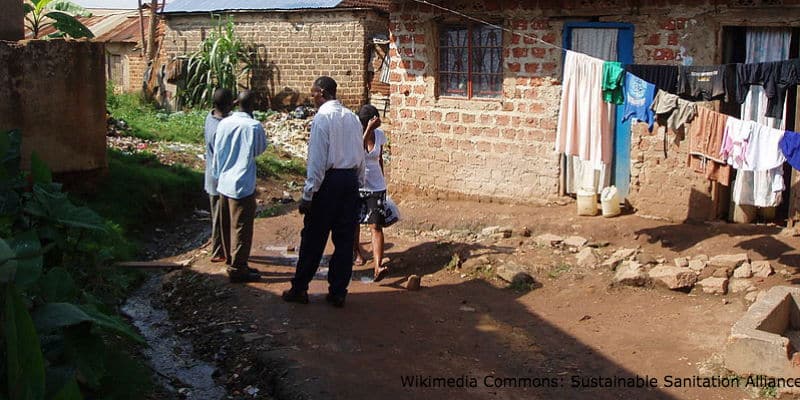Wikimedia Commons: Sustainable Sanitation Alliance | A drainage channel in Kampala, Uganda.
In the overcrowded slums of Kampala, Uganda, there are at least 41 suspected cases of cholera, according to the country’s ministry of health over the weekend. Cholera kills quickly; Kampala’s latest outbreak has already claimed two lives at the time of this writing.
The outbreak is occurring in areas where “poor hygiene practices, improper disposal of domestic and human waste, and high consumption of untreated water” are the norm. Because most people lack toilets, it’s common practice for residents to dump waste in the open trenches, which helps bacteria spread. Charlotte Kusemererwa, who works with the Joy For Children organization in Kampala, explained in The Guardian, “When the rains sweep in, running water carries all kind of waste and dumps it in open drains, causing a massive blockage and hence flooding.”
It would seem that the problem is rather simple: these slums lack adequate sanitation infrastructure to prevent bacteria from spreading. It stands to reason, then, that what Kampala needs more than anything is an influx of infrastructure.
But how do you do it right?
Infrastructure is incredibly costly to build and maintain, and according to Danish economist Bent Flyvbjerg, most projects fall short of expectations. Among the infrastructure projects he’s studied—all in wealthy countries where overt corruption isn’t rife, technical expertise is abundant, and economic productivity is high—nine out of ten mega-projects were over-budget, late, and under-delivered on the projected economic impact laid out by the project designers.
That’s not to say that infrastructure isn’t a worthwhile investment. Both hard infrastructure—like roads, electricity, and sanitation—and soft infrastructure—like legal, healthcare, and education systems—are vital to a society’s economic development. But, to avoid disappointing results, projects must be sustainable. My colleague Efosa Ojomo offered two tips to help governments rethink their approach to impactful infrastructure:
1. Start small and leverage innovators
The temptation to copy and paste grand infrastructure projects from prosperous nations is alluring. All too often poor countries build hospitals and schools with the goal of mimicking those in rich countries. In theory poor nations should strive to build the best infrastructure they can. But unfortunately many of these projects fail because they don’t start small. And usually large projects are not only prohibitively costly, but also incredibly difficult to manage.
For example, in the early 19th century, the United States federal government undertook what many consider to be its most ambitious project, construction of the “National Road” from Maryland to West Virginia, nearly 400 miles long. Soon after, however, the government ran out of money and abandoned the project. Fortunately, many smaller private companies—private turnpikes—picked up road construction projects all across the country. These projects were much smaller, focused, and easier to manage. And although they might have been small projects to begin with, most of these “private-turnpike-built-roads” are responsible for today’s incredibly complex transportation infrastructure.
2. Understand the value the infrastructure stores or transports
Infrastructure can be thought of as the most efficient mechanism a society has designed to store or transport value (or innovations). As such, whatever value infrastructure stores or transports—be it knowledge for schools, healthcare for hospitals, vehicles for roads, cargo for trucks, trains, or planes, and so on—must be able to pay for the construction and maintenance of the infrastructure. If it can’t, the infrastructure won’t be sustainable.
Consider the following example. In 2017, Kenya took out a loan from China to build a $3.2 billion rail line from Mombasa, a port city in southern Kenya to Nairobi, the country’s capital. Many, including the president of the country, celebrated the completion of the rail line. But roughly a year after its completion, The Economist published an article that suggested the rail line “may never make money.” So far, there doesn’t seem to be enough “value” being moved on the rail to pay back the loan and to maintain the infrastructure. And according to a World Bank study, only if the rail line moved 20 million tons of goods—all the value at the Mombasa port—would it be financially sustainable. At best, estimates suggest it will move half that amount.
This is why many infrastructure projects, especially in poor countries, are not sustainable. Governments build roads that aren’t maintained because there aren’t enough cars—or value—being transported on the roads to pay for the maintenance, typically through gas taxes. They build world-class hospitals but there aren’t enough paying customers who can afford the world-class healthcare. So, over time, roads, hospitals, and other infrastructures, crumble.
Before taking on a new infrastructure project governments must first assess whether the value that infrastructure will store or transport can sustain it. If the answer is no, then they must also develop a strategy of enabling the development of innovations that can pay for the infrastructure development.
As the Ugandan government struggles to contain the current outbreak, it must do whatever it can in the short term. Once the dust settles, and discussions rightly turn to the need for adequate sanitation infrastructure in Kampala’s slums, the government would be wise to remember: not all infrastructure is created equal.



